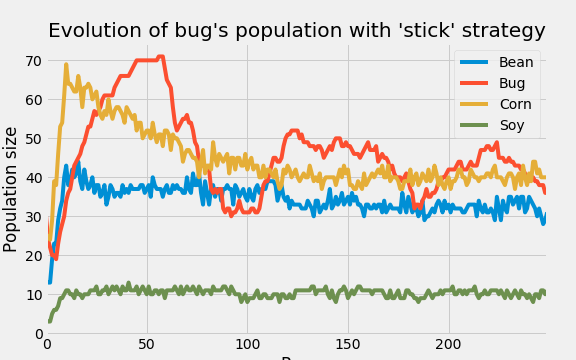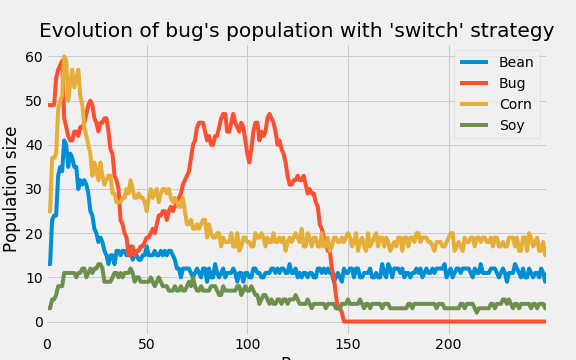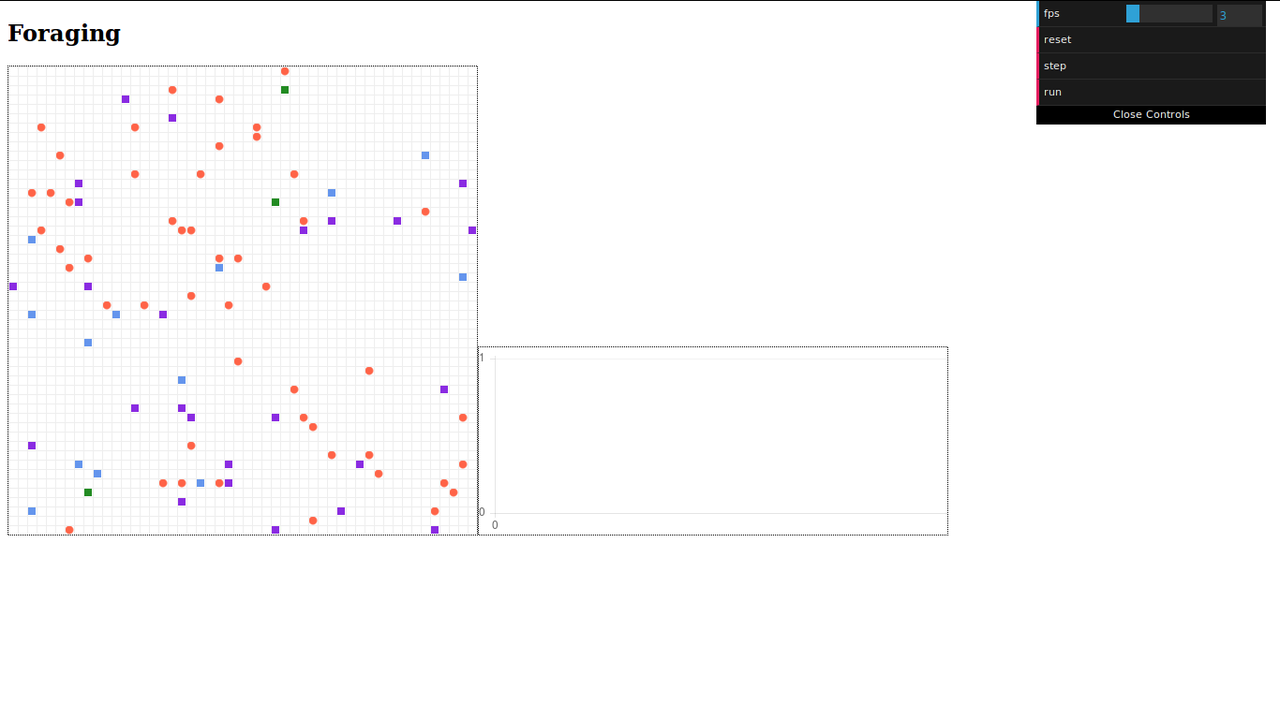In this post, we introduce Mesa a library written in Python3 for Agent-Based Modeling (ABM). Agent-based modeling is a growing topic of interest in many scientific disciplines, due to its flexibility for modeling complex dynamical systems. Agent-based models (ABMs) consist of autnomous, interacting computational objets, called agents within a given environment.
We will introduce the components of of Mesa through a simple foraging model. In this model, a forager (a bug) walks around, searching for foods. We have three different kind of food resources: bean, corn and soy. Foods differ from their growth rate, density on the landscape, and thier starting energy level.
A Mesa model consists of different modules. Here is how the model folder might look:
foraging/ | |---- __init__.py | |---- agents.py | |---- model.py | |---- resources.py | |---- server.py | |---- utils.py
Without further ado, we specify the components of our foraging model.
Environment
One of the component of an ABM system is the Environment. The environment is
where global variables are set up and managed like the number of agents, the scheduler,
or the space where the simulation takes place. In Mesa, the environment is handle
by a the Model class. This class takes a seed keyword.
We inherit that class to create our own environment.
foraging/model.py
from mesa.model import Model class Foraging(Model): number_of_bean = 0 number_of_corn = 0 number_of_soy = 0 def __init__(self, num_bug=50, seed=42, strategy=None): super().__init__(seed=seed) self.number_of_bug = num_bug if not(strategy in ["stick", "switch"]): raise TypeError("'strategy' must be one of {stick, switch}") self.strategy = strategy
The environment defines the space where the agents evolve. The space range from simple square grid to complex geospatial space. In this post, the agents evolve within a simple square grid where each colored cell indicades the presence of an agent and the color indicates the type of agent (we will come to that later). We add the space in our environment.
foraging/model.py
from mesa.model import Model from mesa.space import SingleGrid class Foraging(Model): number_of_bean = 0 number_of_corn = 0 number_of_soy = 0 def __init__(self, width=50, height=50, torus=True, num_bug=50, seed=42, strategy=None): super().__init__(seed=seed) self.number_of_bug = num_bug if not(strategy in ["stick", "switch"]): raise TypeError("'strategy' must be one of {stick, switch}") self.strategy = strategy sefl.grid = SingleGrid(width, height, torus)
The environment also defines a scheduler that manages the agents at every time step. The choice of the type of scheduler is very important since it specifies how (in which order) the state of the agents is updated. In this post, we use a random scheduler. It means that at every time step, agents are choose at random at thier state is updated.
foraging/model.py
from mesa.model import Model from mesa.space import SingleGrid from mesa.time import RandomActivation class Foraging(Model): number_of_bean = 0 number_of_corn = 0 number_of_soy = 0 def __init__(self, width=50, height=50, torus=True, num_bug=50, seed=42, strategy=None): super().__init__(seed=seed) self.number_of_bug = num_bug if not(strategy in ["stick", "switch"]): raise TypeError("'strategy' must be one of {stick, switch}") self.strategy = strategy self.grid = SingleGrid(width, height, torus) self.schedule = RandomActivation(self)
Since the purpose of an ABM is to study the behaviour of a system under different
conditions, we need a way to collect the relevant data of the system while it is
running. The relevent data in this example being the number of food resources (bean, corn, soy)
and the number of foragers (bug) at each time step. This is handle in Mesa with the
DataCollector class.
foraging/model.py
from mesa.model import Model from mesa.space import SingleGrid from mesa.time import RandomActivation from mesa.datacollection import DataCollector class Foraging(Model): number_of_bean = 0 number_of_corn = 0 number_of_soy = 0 def __init__(self, width=50, height=50, torus=True, num_bug=50, seed=42, strategy=None): super().__init__(seed=seed) self.number_of_bug = num_bug if not(strategy in ["stick", "switch"]): raise TypeError("'strategy' must be one of {stick, switch}") self.strategy = strategy self.grid = SingleGrid(width, height, torus) self.schedule = RandomActivation(self) data = {"Bean": lambda m: m.number_of_bean, "Corn": lambda m: m.number_of_corn, "Soy": lambda m: m.number_of_soy, "Bug": lambda m: m.number_of_bug, } self.datacollector = DataCollector(data) def step(self): self.schedule.step() self.datacollector.collect(self) if not(self.grid.exists_empty_cells()): self.running = False
The step method of the environment run the model by calling the step
method of the scheduler which in turn call the step method of every agent
which is where the behaviour of the agent is defined.
Agents
Food
On of the agent in this example is the food resource. In this section, we describe the behaiour of a food resource.
A food resource starts with a fixed ernergy and grows at a fixed rate. When the resource is fully frown, it starts to wilt at fixed wilt rate. If the food is fully grown and its energy reachs a certain treshold, the food replicate itself in an empty cell in the neighborhood if there is one, otherwise, nothing is done. If a food has no more energy, it is removed from the environemnt.
foraging/resources.py
import random from mesa.agent import Agent class Food(Agent): fully_grown = False def __init__(self, unique_id, model, pos=None): super().__init__(unique_id, model) self.pos = pos def step(self): if self.fully_grown: self.energy -= self.wilt_rate else: self.energy += self.growth_rate if self.energy >= self.max_growth: self.fully_grown = True # new Food if self.fully_grown and (self.energy >= self.max_growth): neig = self.model.grid.get_neighborhood(self.pos, True, False) is_empty = self.model.grid.is_cell_empty if any(map(is_empty, neig)): empty = list(filter(is_empty, neig)) pos = random.choice(empty) food_name = type(self).__name__.lower() attr_name = "number_of_{}".format(food_name) last = getattr(self.model, attr_name) new_food = type(self)(last + 1, self.model) self.energy -= new_food.energy setattr(self.model, attr_name, last + 1) self.model.grid.place_agent(new_food, pos) self.model.schedule.add(new_food) # Death if self.energy <= 0: food_name = type(self).__name__.lower() attr_name = "number_of_{}".format(food_name) last = getattr(self.model, attr_name) self.model.grid._remove_agent(self.pos, self) self.model.schedule.remove(self) setattr(self.model, attr_name, last - 1)
Forager
In this section, we describe the behavior of the forager (bug) in this example.
Each forager borns with a fixed amount of energy, searches for foods in its neighborhood and moves according to the given strategy (describe below). When a forager moves, its energy decrease proportionally to the distance between its current position and the targeted position. When a forager gets old, its energy decreases by a fixed amount. If a forager is adult (is at a certain age), and its energy level is above a certain threshold, the forager gives birth in an empty cell in the neighborhood if there is one, otherwise, moves to a random empty cell eslsewhere if possible. If a forager has no more energy, it dies (i.e. it's removed from the environment).
In the follwing, is the description of each strategy.
- Stick: In this strategy, a forager moves to a random location if there is nothing around him (no neighbors). Otherwise, stay at its current location.
- Switch: In this strategy, at each time step, a forager moves to an empty location in its neighborhood if there is one, otherwise stay at ist current location.
foraging/agents.py
import random from mesa.agent import Agent from foraging.utils import euclidean from foraging.resources import Food class Bug(Agent): treshold = 15 metabolism = 1 energy = 10 strategy = None age = 0 def __init__(self, unique_id, model, pos=None): super().__init__(unique_id, model) self.pos = pos self.move = {"stick": self.stick, "switch": self.switch, } def step(self): self.age += 1 adult = self.age > 5 old = self.age > 50 if old: self.energy -= self.metabolism self.find_food() self.move[self.strategy]() # new Bug has_energy = self.energy >= self.treshold if has_energy and (adult): neig = self.model.grid.get_neighborhood(self.pos, True, False) if any(map(self.model.grid.is_cell_empty, neig)): empty = list(filter(self.model.grid.is_cell_empty, neig)) pos = random.choice(empty) last = self.model.number_of_bug new_bug = Bug(last + 1, self.model) new_bug.strategy = self.strategy self.energy -= new_bug.energy self.model.grid.place_agent(new_bug, pos) self.model.schedule.add(new_bug) self.model.number_of_bug += 1 else: pos = self.model.grid.find_empty() self.move_to(pos) # Death if self.energy <= 0: self.die() def switch(self): neig = self.model.grid.get_neighborhood(self.pos, True, False) pos = random.choice(neig) if self.model.grid.is_cell_empty(pos): self.move_to(pos) def stick(self): neig = self.model.grid.get_neighbors(self.pos, True) if not(neig): pos = self.model.grid.find_empty() self.move_to(pos) def move_to(self, pos): distance = round(euclidean(self.pos, pos)) cost = self.metabolism * distance self.model.grid.move_agent(self, pos) self.energy -= cost def find_food(self): neig = self.model.grid.get_neighbors(self.pos, True, False) if neig: agent = random.choice(neig) if isinstance(agent, Food): self.eat(agent) def eat(self, food): gain = self.age * self.metabolism self.energy += gain food.energy -= gain def die(self): self.model.grid._remove_agent(self.pos, self) self.model.schedule.remove(self) self.model.number_of_bug -= 1 class Bean(Food): density = 0.005 growth_rate = 4 wilt_rate = 2 max_growth = 20 energy = 4 class Corn(Food): density = 0.01 growth_rate = 2 wilt_rate = 1 max_growth = 10 energy = 2 class Soy(Food): density = 0.001 growth_rate = 20 wilt_rate = 10 max_growth = 100 energy = 20
We can now finish to implement our envionment class with the methods to populate agents.
foraging/model.py
from mesa.model import Model from mesa.space import SingleGrid from mesa.time import RandomActivation from mesa.datacollection import DataCollector from foraging.agents import Bean, Corn, Soy, Bug class Foraging(Model): number_of_bean = 0 number_of_corn = 0 number_of_soy = 0 def __init__(self, width=50, height=50, torus=True, num_bug=50, seed=42, strategy=None): super().__init__(seed=seed) self.number_of_bug = num_bug if not(strategy in ["stick", "switch"]): raise TypeError("'strategy' must be one of {stick, switch}") self.strategy = strategy self.grid = SingleGrid(width, height, torus) self.schedule = RandomActivation(self) data = {"Bean": lambda m: m.number_of_bean, "Corn": lambda m: m.number_of_corn, "Soy": lambda m: m.number_of_soy, "Bug": lambda m: m.number_of_bug, } self.datacollector = DataCollector(data) # create foods self._populate(Bean) self._populate(Corn) self._populate(Soy) # create bugs for i in range(self.number_of_bug): pos = self.grid.find_empty() bug = Bug(i, self) bug.strategy = self.strategy self.grid.place_agent(bug, pos) self.schedule.add(bug) def step(self): self.schedule.step() self.datacollector.collect(self) if not(self.grid.exists_empty_cells()): self.running = False def _populate(self, food_type): prefix = "number_of_{}" counter = 0 while counter < food_type.density * (self.grid.width * self.grid.height): pos = self.grid.find_empty() food = food_type(counter, self) self.grid.place_agent(food, pos) self.schedule.add(food) food_name = food_type.__name__.lower() attr_name = prefix.format(food_name) val = getattr(self, attr_name) val += 1 setattr(self, attr_name, val) counter += 1
With all this, we can run our model and examine the results. The way we run a model
with different staring point in Mesa is trough the BactchRunner class which
take a model constructor and a dictionnary of the different parameters to run the
model with. But in this post, we will manually run the model and collect the result.
%matplotlib inline import pandas as pd import matplotlib.pyplot as plt from tqdm import tqdm_notebook from foraging.model import Foraging time = 250 def show(result, stragegy): with plt.style.context("fivethirtyeight"): ax = result.plot(kind="line", figsize=(8,5)) ax.set_xlabel("Run") ax.set_ylabel("Population size") ax.set_title("Evolution of bug's population with '{}' strategy".format(strategy)) def run(time, **kwargs): result = {"Bean": [], "Corn": [], "Soy": [], "Bug": []} model = Foraging(**kwargs) progress = tqdm_notebook(total=time) for t in range(time): model.step() result["Bean"].append(model.number_of_bean) result["Corn"].append(model.number_of_corn) result["Soy"].append(model.number_of_soy) result["Bug"].append(model.number_of_bug) progress.update() progress.close() return pd.DataFrame(result)
Run the model with stick strategy
strategy = "stick" result = run(time, strategy=strategy) show(result, strategy)

Run the model with switch strategy
strategy = "switch" result = run(time, strategy=strategy) show(result, strategy)

Mesa has an in-browser visualization feature that allows the user to see the model at running in the browser. To use that functionality in our example, we add what follows in our directory.
foraging/server.py
from mesa.visualization.modules import CanvasGrid, ChartModule from mesa.visualization.ModularVisualization import ModularServer from foraging.agents import Bean, Corn, Soy, Bug from foraging.model import Foraging width = 50 height = 50 def food_portrayal(agent): if agent is None: return portrayal = {"Shape": "rect", "Filled": "true", "w": 0.8, "h": 0.8, "Layer": 0} if type(agent) is Bean: portrayal["Color"] = "cornflowerblue" elif type(agent) is Corn: portrayal["Color"] = "blueviolet" elif type(agent) is Soy: portrayal["Color"] = "forestgreen" elif type(agent) is Bug: portrayal["Shape"] = "circle" portrayal["Color"] = "tomato" portrayal["r"] = 1 portrayal["Layer"] = 1 return portrayal bean = {"Label": "Bean", "Color": "cornflowerblue"} corn = {"Label": "Corn", "Color": "blueviolet"} soy = {"Label": "Soy", "Color": "forestgreen"} bug = {"Label": "Bug", "Color": "tomato"} canvas = CanvasGrid(food_portrayal, width, height) chart_count = ChartModule([bean, corn, soy, bug]) server = ModularServer(Foraging, [canvas, chart_count], name="Foraging", strategy="stick") server.launch()
Once added, we launch the model at the console like this:
$ python3 foraging/server.py
When launch, something like the figure below opens up in your browser and you can press the run button to run the model.

Conclusion
In this post, we introduce Mesa, an agent-based modeling framework through a simple foraging model. Mesa is still in its infancy but in the near future, itends to have the power of a full featured ABM's framework. To have an idea of what is coming next, you can watch this presentation by Jackie at PyDataDC 2016.